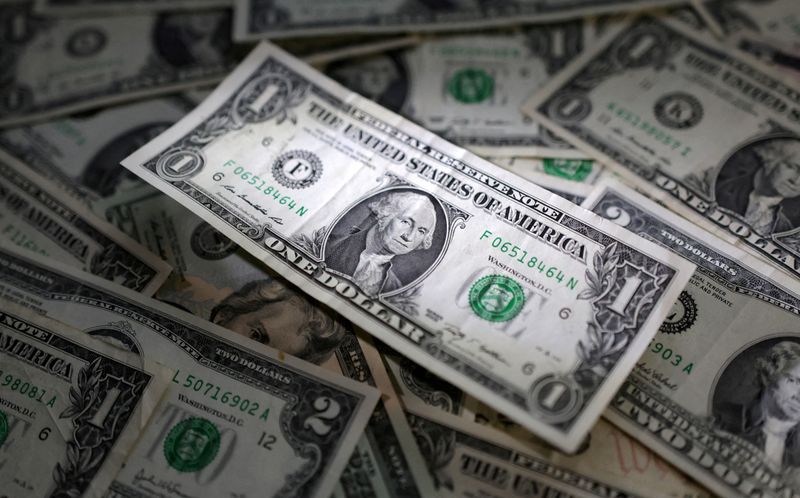Forex
Dollar rebounds as Fed’s Powell sees March rate cut as unlikely


© Reuters. FILE PHOTO: U.S. dollar banknotes are seen in this illustration taken March 10, 2023. REUTERS/Dado Ruvic/Illustration/File Photo
By Karen Brettell
NEW YORK (Reuters) – The dollar gained on the euro and pared losses against the yen on Wednesday after Federal Reserve Chair Jerome Powell said that a rate cut in March was not the U.S. central bank’s “base case.”
It came after the Fed offered a neutral and less dovish outlook on rates than many investors had expected.
The Fed gave an “extremely neutral, non-committal statement”, said Karl Schamotta, chief market strategist at Corpay in Toronto.
The U.S. central bank left interest rates unchanged and dropped a longstanding reference to possible further hikes in borrowing costs. But it gave no hint that a rate cut was imminent.
“Traders thought that with the shift in the bias towards neutral that the Fed would accompany this pivot with dovish language. But the Fed did not. If anything, the Fed added some hawkish language in the text,” said Thierry Albert Wizman, global FX and rates strategist at Macquarie in New York.
Fed Chair Jerome Powell said in a press conference that the Fed would need to see more favorable data to be sure it was time to lower rates. “We do have confidence but we want to get greater confidence” that cooling inflation data was sending “a true signal”, he said.
The was last up 0.26% on the day at 103.66. It is on track for a 2.3% gain this month, the best month since September.
Traders are now pricing in a 38% probability that the Fed will cut rates in March, down from 59% earlier on Wednesday. It has fallen from 89% a month ago.
Investors are also focused on Friday’s U.S. jobs report for January, which is expected to show that employers added 180,000 jobs during the month.
The ADP National Employment Report showed on Wednesday that private payrolls increased by 107,000 jobs last month, fewer than economists’ expectations of 145,000 jobs.
The dollar has rebounded this year as U.S. economic data shows a still resilient economy and one that has a better outlook than comparable regions including the euro zone.
The euro fell 0.4% to $1.08005 and got as low as $1.07950, the lowest since Dec. 13. It is on pace for a 2.2% loss this month, the worst month since September.
Data earlier on Wednesday showed that German inflation eased slightly more than expected in January to 3.1%, helped by a drop in energy prices.
The dollar fell 0.25% to 147.26 yen. The Japanese currency has weakened due to the wide gap between U.S. and Japanese interest rates.
The greenback is on track for a 4.5% monthly gain against the yen, the largest since February last year, as weak wage data and cooling inflation leave room for the Bank of Japan to take its time raising rates.
Bank of Japan policymakers discussed in January the likelihood of a near-term exit from negative interest rates and scenarios for phasing out the bank’s massive stimulus program, a summary of opinions at the meeting showed on Wednesday.
The summary highlights a growing view within the board that conditions were falling in place to soon pull short-term interest rates out of negative territory, which would be Japan’s first interest rate hike since 2007.
Sterling fell 0.28% to $1.26630 before the Bank of England’s policy announcement on Thursday, where rates are also set to be unchanged.
In cryptocurrencies, bitcoin fell 1.57% to $42,864.

 Forex3 years ago
Forex3 years agoForex Today: the dollar is gaining strength amid gloomy sentiment at the start of the Fed’s week

 Forex3 years ago
Forex3 years agoUnbiased review of Pocket Option broker

 Forex3 years ago
Forex3 years agoDollar to pound sterling exchange rate today: Pound plummeted to its lowest since 1985

 Forex3 years ago
Forex3 years agoHow is the Australian dollar doing today?

 Cryptocurrency3 years ago
Cryptocurrency3 years agoWhat happened in the crypto market – current events today

 World3 years ago
World3 years agoWhy are modern video games an art form?

 Commodities3 years ago
Commodities3 years agoCopper continues to fall in price on expectations of lower demand in China

 Economy3 years ago
Economy3 years agoCrude oil tankers double in price due to EU anti-Russian sanctions





















